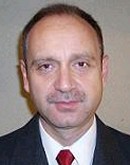
Plenary Lecture
Petri Nets Saliency Models of Multiple Biological Sequences

Associate Professor Calin I. Ciufudean
“Stefan Cel Mare” Universtity of Suceava
Faculty of Electrical Engineering and Computer Science
Department of Automatics and Computers
ROMANIA
E-mail: calin@eed.usv.ro
Abstract: In medicine, computational biology, pattern recognition, string editing and data compression, to name a few research areas, large amounts of data are extracted, pre-processed, selected and classified in order to perform the diagnosis. The classical visual analysis of such a quantity of data is no longer possible, therefore computers are involved in this process and thus, automated systems that recognize biological features have been in use for several years.
There is a strong demand for the development of such automated algorithms and devices, due to the improved video and biological computation techniques that avoid the possibility of the analyst missing/misreading information. Within heuristic approaches there are a number of methods for identifying important input features. Such methods are considered saliency ones mainly due to the fact that they can intuitively model and simulate the mechanisms and signals used in computational biology. Recently, the general problem of selecting a parsimonious salient feature set for computational biology has retained a great deal of interest.
One may notice that non-salient features may reduce the diagnosis accuracy and even make it a NP-hard problem considering that, as the number of features grows, the number of training samples grows exponentially. In order to reduce the size of the extracted input feature samples we focus on determining the longest common subsequence (LCS) for a set of multiple string-sequences in an operation for a wide range of applications in the areas mentioned above.
This presentation is focused on the improvement of the automated medical diagnosis based on biological feature (BF) selection and classification, as we know that biological features represent patterns of important information. Medical diagnostic can be improved if the pattern is comprised by most of the significant biological features. In our study, common sequence measures were employed to determine the saliency of a wide range of applications in the area of medicine, computational biology, as well as string editing, pattern recognition and genetics etc. We assume that an important common sequence salience measure is to find the longest common subsequence (LCS) for a set of n sequences. In order to perform this hard task, we use discrete event formalism, respectively Petri nets and we propose an algorithm for reducing the size of the digraphs.
An interesting application to the ECG signals will demonstrate that salient input features effectively aid the diagnosis process.
Brief biography of the speaker:
• Academic Positions: Assoc. Professor Ph.D. Eng., Dept. of Automatics and Computers, Faculty of Electrical Engineering and Computer Science, “Stefan cel Mare” University of Suceava, Romania.
• Fields of Scientific Activities: Discrete Event Systems, Complex Measurement Systems, Reliability and Diagnosis of Control Systems, Environmental Management.
• He published 8 books and over 120 scientific papers in conference proceedings and journals.
• Honor Member of the Romanian Society of Electrical & Control Engineering - Member of the Romanian Technical Experts Corp.
• Technical Expert of the Romanian Ministry of Justice.
• President of the Romanian Society of Electrical & Control Engineering, Suceava Branch.
• He is a member of the editorial boards of several international scientific journals and conferences of control systems and electric engineering science. He was designated chairmen at 23 international conferences.